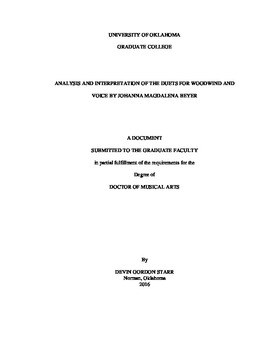| dc.description.abstract | For forty-four years after her death in 1944, Johanna M. Beyer was a relatively unknown composer. Her name started receiving attention in 1988 after the music ensemble Essential Music organized two concerts consisting exclusively of Beyer’s music. On November 10 and 15 of that year, these two concerts were presented in Greenwich House, New York, to celebrate the one hundredth anniversary of Beyer’s birth. Since then, the biographical and analytical scholarship on her life and works has been slowly increasing. In March 2015, the first comprehensive biography of her was published. Yet, despite the growing amount of literature about Beyer, hardly any substantial theoretical analyses of her works exist.
Among her many neglected works, Beyer’s three songs for woodwind and voice—Three Songs for Clarinet and Soprano, Ballad of the Star-Eater (for clarinet and soprano), and Have Faith! (for flute and soprano)—remain practically untouched analytically. The works are fascinating in their construction, being aggressively atonal yet containing an emotional depth and beauty in both text and music. Beyer’s application of dissonant counterpoint is seamlessly interwoven into the musical fabric, yet despite the immense influence of dissonant counterpoint on her compositional oeuvre, no scholarly output exists on her application of this style to her compositional method. Additionally, Beyer’s use of text painting in her songs is instrumental in the formation of motives and the overall structure of her works, yet no information exists as to how her use of text painting affects the development of her songs. In this document, I examine how Beyer uses the dissonant counterpoint techniques laid out in Charles Seeger’s treatise to construct her works. I also discuss her frequent use of text painting and how it affects the structure of each song. Each chapter consists of three parts: introduction, discussion of motivic development, and analysis of text painting. The first part of each chapter provides historical context for the musical work and the poetry that appears in it, the second part examines how Beyer uses dissonant counterpoint techniques to develop her motives, and the third part examines the places in which text painting is used in each piece and how the technique affects the motives and structure of the work. | en_US |
